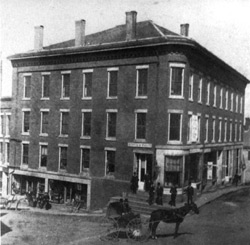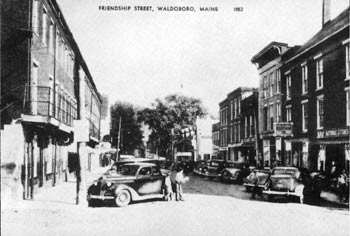
The Fish Block in Waldoboro, largest brick building in the county, burned 1900. The commercial and industrial economic realities of big ship building were reflected in the buildings of Waldoboro, which were, and still are, in contrast to its rural surroundings. Photo: Waldoboro Historical Society |
There are no shipyards left, although down the road in Friendship is Lash Brothers, builder and finisher of many fishing vessels. Names such as Lash, Miller, Black, Feyler, Creamer, Benner and Eugley are common in Waldoboro, and they are all anglicized versions of German names. Miller, for example, was Mueller; Creamer was Kramer.
The last old wharf on the empty harbor is now a lumberyard, and it’s hard to believe that great ships slid down the ways without ballast and were taken downriver and into the pages of history. The view of the Medomak — a Native American name which may mean many alewives — is today more undeveloped than it was in the booming late 1800s.
But there are clues. At low tide, when the clammers are out digging, you can see huge timbers where currents have exposed them in the mud. Storer Lumber Company is still owned by the family that built ships on the site, including what’s said to be the first five-masted schooner, the Governor Ames.
That’s when Waldoboro put itself on the map as wealthy New England merchants exploited the local labor force to build ships that would seldom return to this upriver town. Today, the old U.S. Customs House — later a post office and library — is now for sale.
The Waldoboro along Route One has turned into a sprawling strip of gas stations, banks, modular housing and real estate dealers. More people know about Moody’s Diner than anything else in town. Moody’s, once an all-night beacon for truckers, is now a restaurant with regular hours. The regulars still sit at the counter, though, and shoot the breeze, perhaps wondering at the affluent out-of-staters who retire here and restore antique houses.
Meanwhile, young families borrow money to buy prefabricated houses on lots once cleared for farms. Waldoboro recently voted against a ban on stores such as Wal-Mart Super centers, and a tide of development is erasing the small-town atmosphere. Two years ago townspeople voted for a zoning ordinance that includes an historic village district. The area is where Old Broad Bay first began when Germans landed on an inhospitable shore.
In the early 1700s the first wave of German settlers, lured here by General Samuel Waldo, found the going too tough. It’s said the colony failed in part because of clashes with Native Americans, the rightful owners of the land. Waldo misled early settlers, who thought they would find towns and cities — not wilderness. But he kept on with his scam, and eventually intrepid Germans hung on, eventually naming their town after the ruthless developer who brought them to this hilly, hardscrabble place.
Early Waldoboro settlers shipped cordwood south to Boston, eventually clear-cutting most of the town, hastening the silting of the river. The first roads were laid in 1774, but for generations the only highway was the sea, and sail power ruled the waves. The first brig was reportedly launched in 1771, but by the mid-1800s there were a score of shipyards on the Medomak, launching ship after ship, a thriving business until the early 1900s.

Early 20th century street scene in downtown Waldoboro, much as it appears today. The economy that produced this village community, hidden from the current main road, was not the type of economy that produced the temporary construction along the strip that is now the main road through town. Photo: Waldoboro Historical Society |
Waldoboro, incorporated in 1773, was geographically one of the larger towns in the state. Old maps use prominent type to list the town, indicating it had a reputation that faded long ago. Records of Waldoboro’s impressive shipbuilding era are skimpy, but local historian Mark Biscoe estimates 600 vessels were launched in the town’s golden era, from 1860 to 1910. Twenty-three ships were launched in 1849 alone. In those days the town built more ships than Portland or Belfast and was second only to Bath.
As Biscoe writes in his recent book, Merchant of the Medomak, “Prosperity was to be had for many who had invested their money in local ships, often paying their investors back in the very first voyage.”
In 1888, Levitt Storer, a prosperous shipbuilder, launched the most celebrated five-masted schooner in Waldoboro history; the 232-foot long Governor Ames. She cost $75,000 — a new high — and she was built of Virginia white oak and Georgia pine. Wood was imported because Maine had long ago chopped down its big trees.
This cargo ship had a 1,764-ton carrying capacity and under full sail could spread 7,000 yards of canvas, Biscoe reports. The vessel was named for a Massachusetts governor and was ordered by Captain C.A. Davis and others of Fall River.
The Ames wasn’t the luckiest vessel to set sail. A stray rope at the launching amputated a worker’s foot. Then, on the maiden voyage to fetch coal from Baltimore for Providence, the schooner was entirely dismasted in a gale off Cape Cod. Thanks to Gloucester fishermen, the Ames was towed by steam tug to safety and repaired at a cost of $10,000.
After that, the Ames did pretty well for its owners, carrying coal and lumber to east and west coast ports and sailing as far as Latin America. In 1900, an ebb tide in Bangor pulled her from a Penobscot River anchorage and her 10-inch hawser snapped like a gunshot, Biscoe writes. She dragged over to Brewer, was hauled back into deep water and was made fast “with enough lines on her to hold a battleship.”
Nine years later, after taking on a cargo of 33,000 railroad ties in Georgia, she was caught in a December gale off Cape Hatteras. A sailor who managed to make a raft was the sole survivor of the wreck. A passing steamboat picked him up.
Steam, steel and bigger vessels built elsewhere finally eclipsed Waldoboro and the whole age of commercial sail.
Waldoboro has been home to dairy, poultry and blueberry farms for generations, but only a handful are still operational. Waldoboro once had dozens of mills for lumber, flour and wool. The once-active granite quarry is now a quiet pond. A three-story downtown button factory stayed in business until the l980s, shifting from seashell buttons to plastic. A North Carolina man has slowly been restoring the structure. Medomak Canning Company put up squash under the One Pie label until the 1970s. The latest casualty is the Sylvania light plant, where, for half a century, hundreds of local people made filaments. That business just moved to the Czech Republic.
But the town is far from dead. Medomak Canning’s building is now a seaweed fertilizer plant. Another business makes science kits for schools; a bakery turns out organic bread shipped statewide; and a national antiques magazine is published on Main Street. The new pub is thriving, and it echoes Stahl’s Tavern, which once flourished on Main Street. A former newsstand is an art gallery. There is a sense that the town may revive itself, but that hasn’t happened yet.
Fires took their toll on the town, which once had the largest brick building in the county. Waldoboro is still the biggest town in Lincoln County. Many fine old homes have been demolished, along with a dance hall, hotels, and an entire brick block of shops and apartments.
The old village—you must turn off Route One to find it—is worth a visit. Standing at the town landing you are where many a ship, including the Governor Ames, was constructed. There is an historical display, a ramp and float, and a weathervane of the Ames, all thanks to John Gatcombe, a local teacher who thinks these things shouldn’t be forgotten, and who believes residents deserve public access to the sea.
The same sea that floated the ships carrying immigrant Germans, that floated the ships built by their children and grandchildren, that now floats the lobster boats and clam diggers’ skiffs.
|





